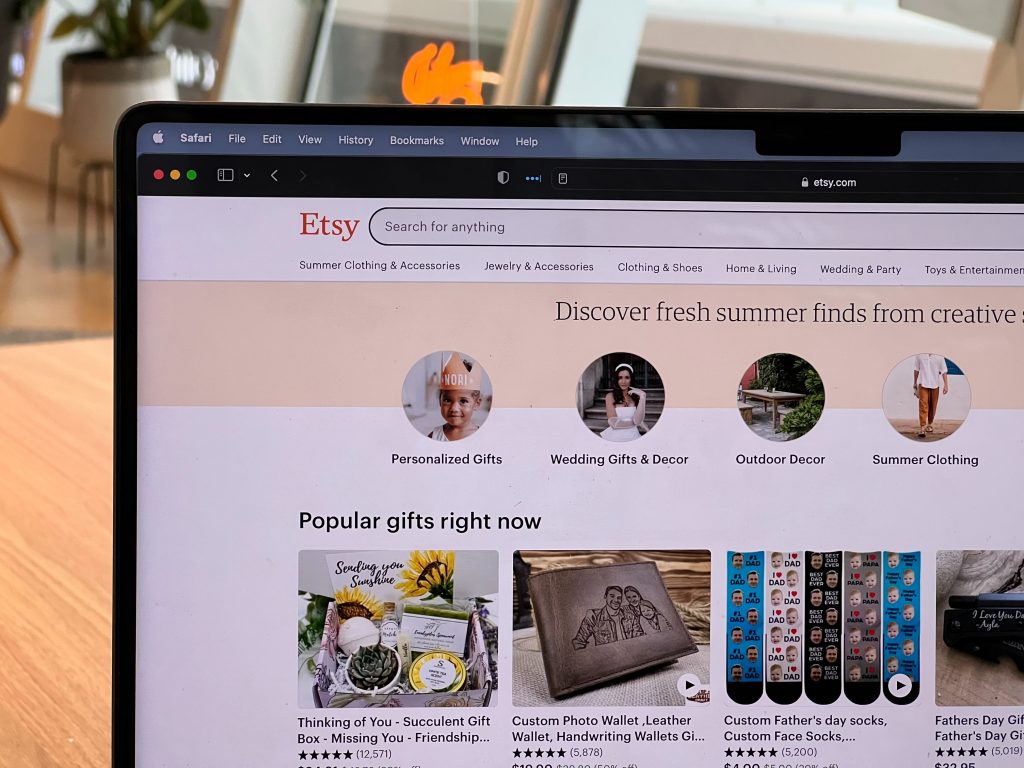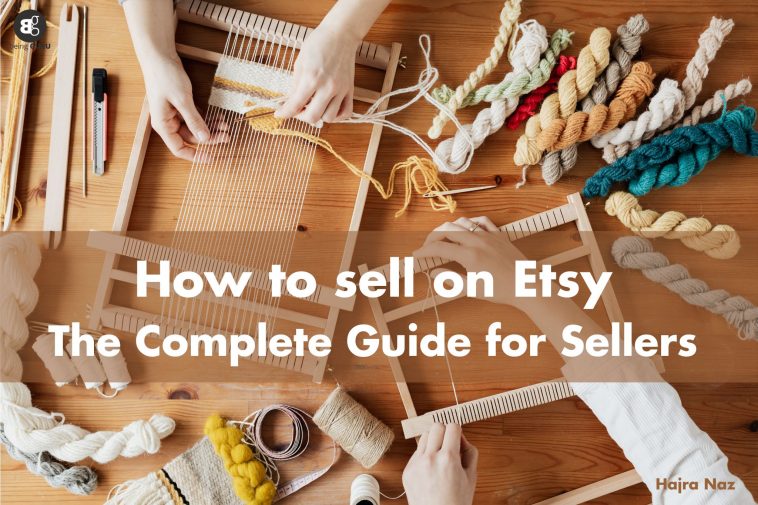Do you have a talent for creating fine handmade goods? As a small business owner, selling products on your website can be challenging. You must figure out the technology, target active buyers, and establish your shop’s policies, to name just a few challenges.
Likely, all your effort won’t be worthwhile if you run a small business or are only doing this as a side hustle. There is, however, a way to open a business without going through the trouble of independently creating a website.
What is Etsy?
Etsy is an online marketplace that brings together buyers and sellers of one-of-a-kind handmade, vintage, and creative items. Customers on Etsy want to buy the results of your artistic abilities.
 Etsy stands apart because it enables individual Etsy sellers to market their goods online to a large global audience.
Etsy stands apart because it enables individual Etsy sellers to market their goods online to a large global audience.
The best part of hand-crafted and vintage objects is their finest features, and Etsy makes the most of this. You can sell a variety of homemade goods on Etsy, including crafts, apparel, and jewelry.
What advantages do Etsy sellers enjoy?
Make sure you fully comprehend the advantages and influence of selling on Etsy as opposed to other internet marketplaces before getting started.
Massive reach:
Etsy helps anyone to boost the visibility of their shop due to its well-known reputation. Almost 96.3 million people purchased items from Etsy in just one year. Via Etsy search, the entire globe will see your shop. The possibilities are only waiting for your creativity to open them up.
Marketing Tools:
Etsy offers every small business a tone of marketing chances due to its extensive reach and influence.
When you launch your Etsy shop, selling on an online marketplace can help you become known as a seller and develop a following of devoted customers. You only need to produce in-demand goods and offer top-notch services.
Possibility of growth:
Any profitable Etsy shop can give the seller a chance to make money while they do what they do best: create. This internet business might provide a flexible approach to making money. Successful vendors can use the money they make from their stores to further their objectives, whether they be personal or professional.
In addition to being a side job, it has the potential to grow into full-time employment that will sustain both you and the company itself with enough success.
Any profitable shop can expand with the help of Etsy. If you keep giving your customers a superior shopping experience and better items, your company may be able to survive.
How to start a business on Etsy?
The next step is to open your shop on Etsy if these advantages appeal to you. To give your future business the greatest possible start, follow the guidelines listed below.
-
Decide whether Etsy is the best platform:
Any company venture’s beginning might be daunting. Always do your research before investing time and energy in anything.
Make sure you are aware of the fact that you cannot sell any items that are mass-produced or that violate Etsy’s rules because they specialize in hand-crafted products and services.
Other than this, the only issues you might have with Etsy will be unique to your company. Before investing your time in this endeavor, make certain that Etsy is a good fit for you.
If not, take into account alternative e-commerce sites like Amazon or eBay or use Shopify connections on your website.
-
Register for an account and launch an Etsy shop:
You must first visit Etsy.com. At the upper right corner of the website, near the shopping cart icon, click “Sign in.” Please sign in if you already have an account. Otherwise, choose “Register” to open a fresh Etsy account. Enter your email, first and last name, and password.
Verify your email address according to the prompts to complete the account creation process. Once finished, sign in right away.
Click your profile symbol in the top right after logging in. The default silhouette is grey, but you are free to change it if you want to make it stand out to potential buyers.
You have a lot of options in the dropdown menu, so acquaint yourself with them all before selecting “Offer on Etsy.” You’ll be taken straight to the seller page by doing this. To create your page, click “Get Started” and then follow the easy instructions.
Here are a few things to keep in mind when you fill out this form. Your responses are used by Etsy to create an algorithm.
These responses will be used by your shop once it has been developed and made public to entice potential customers who match the profile. Hence, be specific in your responses to get the most out of Etsy’s tools for your company.
Moreover, make sure the name of your shop accurately describes what you sell and is memorable and easy to spell.
-
Put your initial product listing online:
It goes without saying that you should accomplish this before doing anything else on your shop page, and Etsy is putting you in a good position to succeed by mandating it. Etsy is very specific in this area and explains what you need to do to launch your first products into the public eye.
Fill out as many product descriptions and listings as you can, even though some are optional. The better, the more specific.
Don’t stress about this initial listing being flawless. Etsy will not display this product until you have made your shop public and used this as a tutorial for submitting your products to the market. Make sure you are familiar with the fundamentals of Etsy listing.
-
Choose a payment method:
Again, Etsy’s explanation is quite self-explanatory. The most important item to take note of is Etsy’s payment method: plaid. Plaid is a safe way to link your bank to Etsy so that payments may be made securely, quickly, and conveniently. akin to a contemporary PayPal. So don’t be concerned about disclosing your credit card details. Leave Plaid and your bank in charge of the security.
Plaid is dependable, but other internet retailers utilize unique techniques for varied reasons. To continue registering as a shop, follow the instructions, fill out your details, and connect to Plaid.
Don’t worry about security; they require access to your bank account to pay you, even though you wouldn’t normally disclose such information with your banking institution.
-
Make your storefront unique:
You have a lot more options to consider now that your shop has officially opened. Check out some of the highlights below because it can be overwhelming. A successful business owner should be familiar with all of the tools, but by looking below, you can get off to a solid start.
Start by personalizing your online storefront, including the banner and shop announcements, store name, icon, cover and profile images, and icon. All of these are unique to you and your company. Use Etsy’s guidance to build a fantastic Etsy business if you are anxious about this stage.
What costs are involved in opening an Etsy shop?
You should be aware of the specific fees associated with selling on Etsy. These Etsy fees will reduce profit, yet they are necessary for a seller on the online shopping site.
Listing fees:
Products must be listed for sale to use the Etsy marketplace. For each listing that you post, you will be charged a listing fee.
The listing charge on Etsy is a set fee of USD 0.20 per listing. Regardless of whether the item is sold, this fee is assessed. While deciding whether to list or not, this is crucial to take into account. While being a minor individual cost, it can build up quickly and have a detrimental impact on profits. When you publish an item, this cost is automatically added to your payment account.
Transaction fee:
When a client makes a purchase, Etsy charges transaction fees. Transaction fees, in contrast to listing fees, are only charged on listings that sell. When it comes to transaction fees on Etsy, there are only a few fundamental factors to keep in mind:
- 5% of the total order amount in your listing is the transaction charge.
- This charge includes both the item’s full price and the cost of shipping.
- For convenience, the transaction fee is immediately debited to your payment account.
The charge for accepting payments:
Processing charges are a predetermined percentage of the item’s overall sale price. It’s significant to remember that this rate differs for each nation. The charges are deducted from the final sales price of the item, which includes the shipping costs and any relevant sales taxes.
Costs for currency conversion:
You may be charged a conversion fee by Etsy if the listing currency is different from the currency of your payment account. Etsy charges a specific fee based on the converted currency because this is a service they offer. By adjusting your listing currency to match the one associated with your Etsy payment account, you can avoid paying this cost.
Shipment charges:
Even though you can choose your shipping rates, Etsy offers a variety of ways to estimate and bill shipping expenses. To do this, shipping profiles can be made for various product types.
Because of the wide range of goods offered on Etsy, they developed this application to assist users in efficiently and profitably shipping their goods.
Make careful you comprehend the shipping requirements for each product so that you can use this tool to estimate shipping expenses for your company.
Use Etsy’s help center as a resource while you create your online shop because there are additional details about each of the costs mentioned above.
What functionalities on the Etsy website are useful?
When thinking about how Etsy positions you for success, there are several features to take into account. Make sure you understand how to use these tools because very few other online marketplace companies provide them.
Automatic Statistics:
The stats tab on your store dashboard is a fantastic tool for performing a rapid analysis of business statistics. All of it is compiled by Etsy based on your online sales, giving you a clear picture of your success and areas for improvement.
Simpler marketing:
Etsy offers a fantastic possibility for growth due to its power and reaches in the internet market, as was previously mentioned. Search analytics, Etsy ads, search engine optimization (SEO), sales and discounts, social network integration, and custom site addresses are all choices under the marketing page.
Using marketing techniques that are available at the click of a mouse, of them can raise the quality of your online store.
Integrations with a focus
There are few things easier than this. To maximize listings and analyze customer trends, bookkeeping, taxes, and inventory analytics are just a few of the 21 partners with whom Etsy offers integrations.
You may easily construct an online store with all of these capabilities available from your dashboard, which are otherwise impossible to execute.
Conclusion:
In conclusion, Etsy is an online marketplace that gives small business owners a platform to offer their handmade, vintage, and original goods. Etsy might be a great choice for sellers thanks to its wide audience, comprehensive marketing resources, and room for expansion. To start a business on Etsy, you must create an account, open a store, list your first few products, and select a payment method. Before putting in the time and effort, sellers must confirm that Etsy is the best platform for their company.




